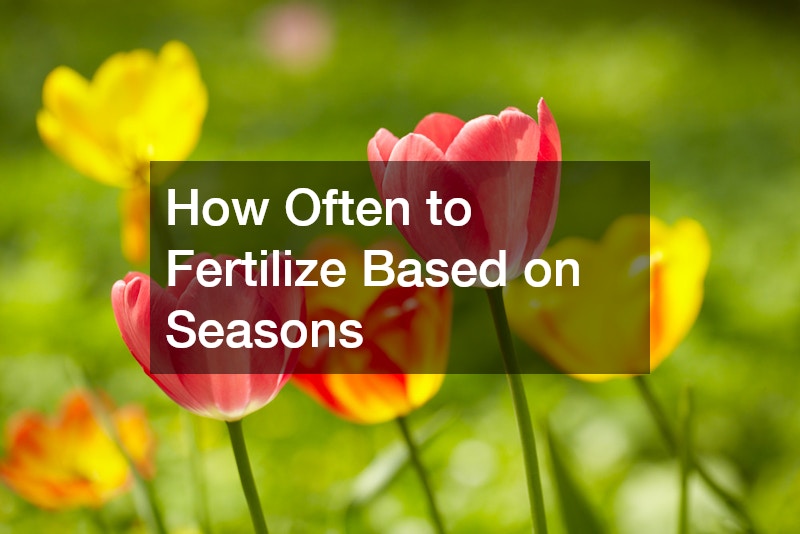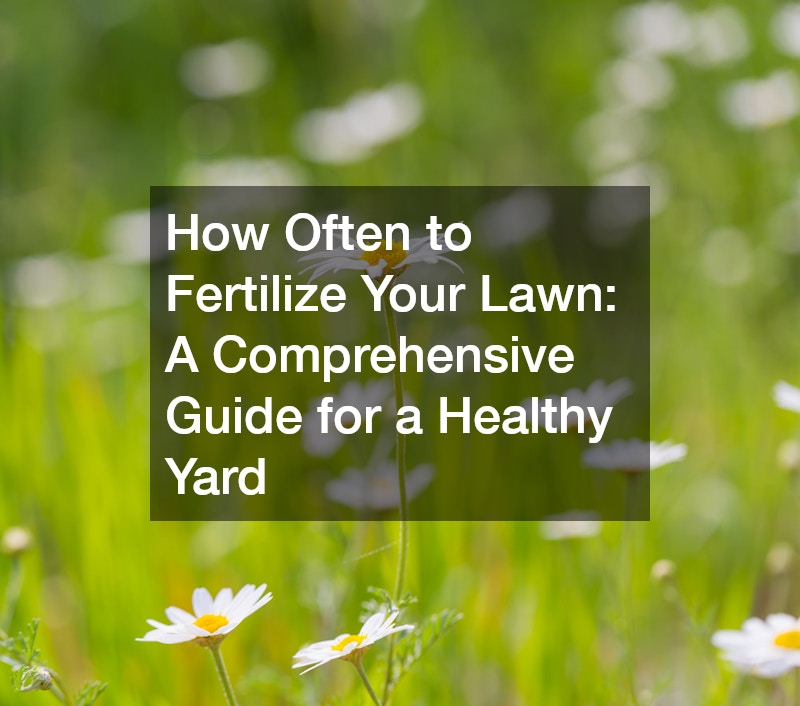How Often to Fertilize Your Lawn: A Comprehensive Guide for a Healthy Yard
A healthy, vibrant lawn is the crown jewel of any home’s landscape, but maintaining that lush green look requires more than just mowing and watering. Fertilizing your lawn at the right time and frequency is key to ensuring that your grass gets the nutrients it needs to grow strong and thrive. But how often should you fertilize your lawn? The answer depends on several factors, including the type of grass, the season, and your region’s climate.
This guide will explain the best practices for fertilizing your lawn and provide helpful tips to ensure you achieve the thick, green yard you’ve always wanted.
Why Fertilizing Your Lawn Is Important
Grass needs nutrients like nitrogen, phosphorus, and potassium to grow strong and maintain its health. These nutrients are often depleted from the soil over time due to weather conditions, mowing, and even grass growth itself. Fertilizing your lawn replenishes these essential nutrients, encouraging thicker, greener grass and helping your lawn resist weeds, diseases, and drought stress.
Factors That Influence How Often to Fertilize
Before diving into the specifics, it’s essential to consider the factors that determine how often you should fertilize your lawn:
- Grass Type: Different types of grass have different fertilization needs. Cool-season grasses like fescue and Kentucky bluegrass have different nutrient requirements than warm-season grasses like Bermuda and zoysia.
- Climate: The climate where you live, including temperature and rainfall patterns, can affect how quickly nutrients break down in the soil and how often your lawn needs feeding.
- Soil Quality: Soil testing can provide valuable information on your soil’s nutrient levels, helping you determine how often and what fertilizer to apply.
- Lawn Usage: Lawns that experience heavy foot traffic or stress from pets, sports, or play may require more frequent fertilization to repair damaged areas and stay healthy.
How Often to Fertilize Based on Grass Type
The frequency of fertilization largely depends on the type of grass in your lawn. Here’s a breakdown of how often different grass types typically need to be fertilized:
1. Cool-Season Grasses
Cool-season grasses grow best in cooler temperatures, typically thriving in spring and fall. Common cool-season grasses include:
- Fescue
- Kentucky Bluegrass
- Ryegrass
These grasses grow most actively during the cooler months and may go dormant during the hot summer. Fertilizing them at the right time is crucial for their health.
- Fertilization Frequency: For cool-season grasses, fertilize two to four times a year, with the most important applications being in early fall and late spring. Focus on applying a heavier dose of fertilizer in the fall, as this helps the grass develop strong roots before the winter and promotes growth in the spring.
- Key Months:
- First application: Early spring (March-April)
- Second application: Late spring (May-June)
- Optional summer application (for stressed lawns)
- Third application: Early fall (September)
- Fourth application: Late fall (October-November)
2. Warm-season grasses
Warm-season grasses grow best during the warmer months and thrive in hot, southern climates. Common warm-season grasses include:
- Bermuda
- Zoysia
- St. Augustine
- Centipede
These grasses enter dormancy in the winter, so fertilizing them during their active growth season (late spring through summer) is crucial.
- Fertilization Frequency: Warm-season grasses benefit from three to five fertilizer applications each year, with most applications occurring between late spring and early fall.
- Key Months:
- First application: Late spring (April-May)
- Second application: Early summer (June)
- Third application: Mid-summer (July)
- Optional fourth application: Late summer (August-September)
How Often to Fertilize Based on Fertilizer Type
The type of fertilizer you use will also influence how often you need to fertilize your lawn. Fertilizers generally fall into two main categories: slow-release and quick-release.
1. Slow-Release Fertilizer
Slow-release fertilizers break down gradually over time, providing a steady supply of nutrients to your lawn for several weeks or even months. Because of their prolonged action, you won’t need to fertilize as frequently.
- Fertilization Frequency: Apply slow-release fertilizer every 6-10 weeks, depending on your grass type and growing season. This type of fertilizer is ideal for those who prefer a low-maintenance approach to lawn care.
2. Quick-Release Fertilizer
Quick-release fertilizers provide an immediate nutrient boost to your lawn, but their effects wear off faster than slow-release options. They’re ideal for giving grass a quick green-up but may require more frequent applications.
- Fertilization Frequency: Apply quick-release fertilizer every 4-6 weeks during the growing season. However, be careful not to over-fertilize, as this can lead to nutrient burn, which can damage your lawn.
How Often to Fertilize Based on Seasons

Seasonal changes play a crucial role in determining how often you should fertilize your lawn. Fertilizing at the right time of year will ensure that your lawn gets the nutrients it needs when it’s actively growing and prevent over-fertilization during dormant periods.
1. Spring
Spring is an essential time for fertilizing cool-season grasses and the start of the fertilization period for warm-season grasses. A light application of fertilizer in early spring helps grass recover from winter dormancy and encourages healthy growth.
- Cool-Season Grass: Fertilize in early spring (March-April).
- Warm-Season Grass: Fertilize in late spring (April-May) once the grass has started growing.
2. Summer
During the summer, warm-season grasses are in full growth mode, requiring regular feeding to maintain their lush appearance. Cool-season grasses, on the other hand, may struggle with heat stress and don’t need as much fertilization unless they show signs of nutrient deficiency.
- Cool-Season Grass: Only fertilize if necessary, especially during periods of drought or extreme heat.
- Warm-Season Grass: Fertilize in early and mid-summer (June-July).
3. Fall
Fall is a critical time for fertilizing cool-season grasses. Applying fertilizer in the early fall helps these grasses recover from summer stress and build strong roots before winter. Warm-season grasses, however, begin to slow down in growth as temperatures drop, so they won’t need as much fertilizer.
- Cool-Season Grass: Fertilize in early and late fall (September-November).
- Warm-Season Grass: A final application in late summer or early fall (August-September) can help prepare your lawn for dormancy.
4. Winter
Most grasses, both cool and warm-season, enter a period of dormancy during the winter. During this time, you should avoid fertilizing, as it’s unnecessary for the grass and can lead to nutrient runoff or waste.
- Fertilization Frequency: Avoid fertilizing your lawn during the winter months.
Soil Testing: An Essential Step
For optimal fertilization, conduct a soil test every 2-3 years to assess the nutrient levels in your lawn. Soil testing helps you determine the exact fertilizer blend your lawn needs, whether it’s higher in nitrogen, phosphorus, or potassium. It also provides insight into the pH levels of your soil, helping you adjust your fertilization schedule and plan accordingly.
Signs That Your Lawn Needs Fertilizing
If you’re unsure whether it’s time to fertilize, here are some signs your lawn may need a nutrient boost:
- Yellowing or browning grass: Indicates nutrient deficiency, particularly in nitrogen.
- Thin or patchy growth could mean your lawn isn’t receiving enough phosphorus, which supports root growth.
- Weeds: An increase in weeds may be a sign that your grass is not strong enough to outcompete them due to a lack of nutrients.
Conclusion
The key to a healthy, thriving lawn lies in regular, well-timed fertilization. By understanding your grass type, soil needs, and climate conditions, you can create a fertilization schedule that provides your lawn with the nutrients it needs to stay vibrant and green all year long. Whether you’re maintaining a cool-season or warm-season lawn, fertilizing two to five times per year is usually sufficient. Be sure to monitor your lawn’s health and adjust your fertilization routine based on its specific needs.
A well-fertilized lawn is a beautiful lawn, and with the right approach, you can enjoy the lush green yard of your dreams!

